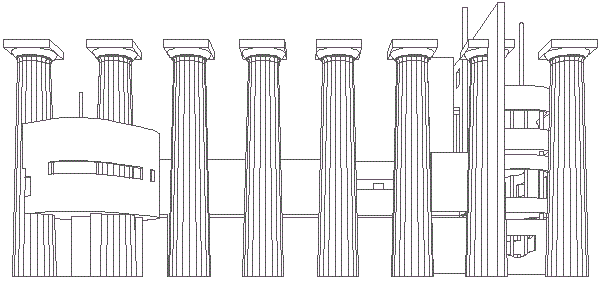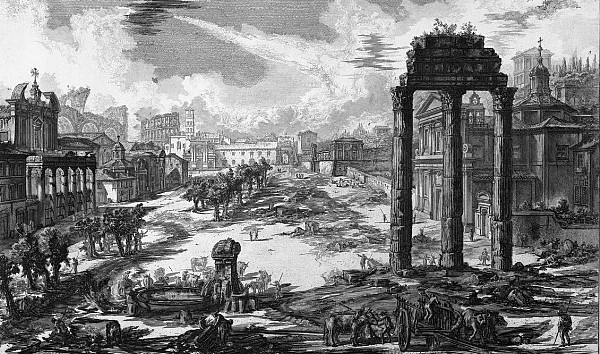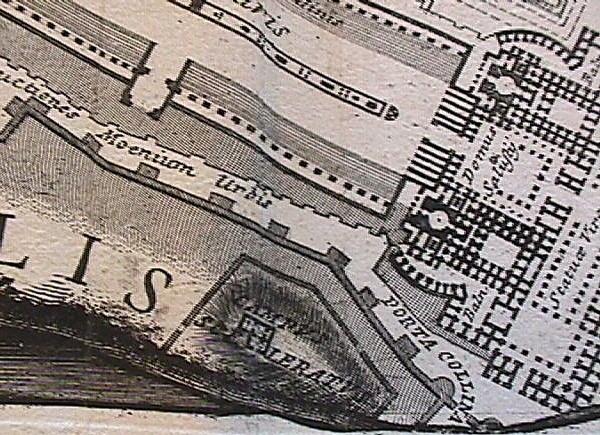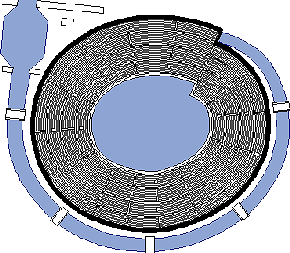ataxonomic castle jazz
alphabetical, polychromatic, numerical, calligraphic and above all of course pictorial reliant on the history of painting.
Are you familiar with Greenaway's Leonardo's Last Supper (2008) and Nightwatching (2007)? Regarding an article in Art in America (February 2009):
"Finally read the article, and yes it would have been more complete if the notion of reenactment was also addressed, as reenactment involves all the issues: reproduction, cloning, authenticity, degrees of separation, even, to some extent, space-time. I'd say the degrees of separation issue is here the most important in that, like you mention, the reproductions come extremely close to the original, and can even occupy the space of the original, but the reproductions can never be the original. I'm reminded of that aspect of calculus where the curve continues to more and more closely approach + or - 1 but never reaches the actual integer itself. [At least I hope I'm remembering correctly.]
"Bifuracted authenticity" is an interesting notion, but, in terms of authenticity, it's a little misleading--there is still really only one authentic work (the reproduction Marriage of Cana even in original context is still a reproduction). Nonetheless, it brings to mind notions of the Baroque--"Within his double theater Bernini capsulized the beginning of Western culture's new bifurcation of the real and the illusory, introduced mirroring as a henceforth dominant (post) Baroque (stylistic) theme, and, at base (or should I say at the ultimate end), inverted reality into a reenactment of its own illusory mirror (--is this perhaps also the genesis of historiography?)." Plus, the mystical notion of bilocation, or is it actually something scientific as in the space-time continuum? Is the match of the Campo Marzio Axis of Life and the Benjamin Franklin Parkway an example of "bifurcated authenticity"?
So, generally, my take on the article is that 'reenactment' is missing and really should have been included. Greenaway essentially performed two reenactments--one the reenacted natural lighting in situ, and two the reenacted lighting on the reenacted painting at another/nearby site--and Factum Arte reenacted the Marriage of Cana at its original site.
Here a Versailles, There a Versailles, Everywhere a Versailles, sigh--going Baroque in the space-time continuum!"
I have seen Greenaway's ZOO only once (like 11 years ago), and liked all the doubleness. I almost saw it a second time a couple of months ago--I borrowed a DVD from the local free library, but never got around to watching it again. Time for take two, I suppose.
anatomical ataxonomic imaginations
extreme, fertile, conceptional, assimilating, metabolic, osmotic, electro-magnetic, all-frequency
The genesis of Quondam (as a virtual museum of architecture) involved comparative architectural scale. That's not so evident within Quondam's make-up now, but if I go back to Quondam's ur-state, it was the realization that once architecture was mediated digitally via CAD, it became very easy to compare architecture(s) (within the digital realm) at "real size"--very much like having a life size museum of architecture at your finger tips. By 1992 I had a model of Hejduk's Wall House II and a model of a column of the Parthenon--each generated for completely separate reasons. Right now I'm not exactly sure why, but one day in 1993 it dawned on me to merge the two databases to see how the two architectures compared:

The row of columns represents the actual positioning along the Parthenon's pedimental fronts.
Beyond that, Quondam always tries to remain true to (its) virtuality.
virtual 1 : of, relating to, or possessing a power of acting without the agency of matter 2 : notably effective 3 : being functionally or effectively but not formally of its kind
More recently, I'm just beginning to think about mediation in terms of "the function or activity of an intermediate means or instrumentality of transmission." In this case, thinking about the virtual and digital as an "instrumentality of architectural transmission."
| |
2013.12.13 19:48
12 December

...it looks as if the Temple of Vesta is not within the Piranesi perspective 'view' of the Roman Forum. The three columns with entablature belong to the Temple of Castor and Pollux, and the round Temple of Vesta would be right in the center of the view within the clearing in front of the two tiny figures. I'm guessing the temple base was still buried in Piranesi's time, and the few columns of the round temple that are in the Forum today are a reconstruction of 20th century vintage. Note, too, how the church facade seen through the three columns does not exist in our time.
The Roman Forum is not delineated within the Ichnographia Campus Martius, but Piranesi did draw a reconstructed plan of the Roman Forum within volume one of La Antichita Romane--that plan is nowhere close to what we know the plan to be today.
"The Vestals, priestesses of the goddess Vesta, whose temple was opposite their house, were selected among the daughters of patrician families between six and ten years of age.
They were exempt from the common law, had many privileges and great political importance, often interposing to save a life, or to restore harmony at times of crisis. They sat in seats of honour at public games and were almost the only citizens allowed to drive within the walls. Their duty was to watch by night and by day the sacred fire in the Temple, and to guard the Palladium. If the fire was allowed to go out, the Vestal in charge was scourged for her carelessness; if she violated her vow of chastity, she was condemned to be buried alive."
The place where Vestals were buried, the Campus Sceleratus, is delineated within the Ichnographia Campus Martius, but, unless you are looking at an actual engraving of the Ichnographia, you are not likely to discern its label:

I believe that I once read somewhere that it was a criminal offense to murder any virgin in Rome, thus the quandary of how execute a fallen Vestal, hence live burial at the Campus Sceleratus.
| |
By the way, the small exhibit at Quondam mentioned above was innuendo.
What I find interesting is that the notion of a god having sex with a virgin is at the very foundation of Christianity. Here's something a wrote just over 10 years ago:
Re: Bib. for Cyrillona's Mariology?
2003.08.09 13:32
John,
Thank you for the Graef citation. If Graef does indeed confuse Immaculate Conception with Annunciation/Incarnation, then this is one more example where such a mistake is made within modern scholarship. I have become very intolerant of this mistake after finding it several times within contemporary architectural theory texts. I even see this presence of misinformation compounded because it implicates not only authors, but editors/review peerage as well. This mistake needs broad/public attention within the realm of scholarship simply to cease the perpetuation of its existence.
It is the Annunciation, as reported by Luke 1:26-38, where a series of events are clearly described.
1. (26) The angel Gabriel is sent by God to Nazareth. The presence of an angel already constitutes a miraculous event, a theophany.
2. (27) The angel is sent to a betrothed virgin named Mary. Here Scripture clearly states that Mary is a virgin and that she is promised in marriage to Joseph.
3. (28) In greeting, Gabriel exalts Mary; "the Lord is with thee" reiterates the theophany, thus Mary's being "full of grace" and "Blessed among women" is Divinely sanctioned.
4. (29) Mary is troubled by such a greeting, signifying her overall innocence in this situation.
5. (30) Gabriel assures Mary of her safety within the theophany taking place.
6. (31) Gabriel 'announces' to Mary that she will conceive and subsequently give birth to a boy, Jesus.
7. (32-33) Gabriel Highly exalts the nature of Mary's announced offspring, indeed to the point of infinity.
8. (34) Mary exclaims confusion at the announcement, while she herself proclaims her virginity.
9. (35) Gabriel tells Mary the Holy Spirit will come upon her, the Most High will overshadow her, and the Holy One to be born will be called the Son of God. Gabriel essentially announces the soon forthcoming of the Trinity, a complete theophany.
10. (36) Gabriel then announces the Precursor, John the Baptist.
11. (37) "for nothing shall be impossible with God."
12. (38) Mary's ultimate reply, "Behold the handmaid of the Lord; be it done to me according to thy word," is extremely important on two counts. First, it is at the moment of Mary's complicity that the Incarnation (the Word becoming flesh) occurs. (Note Gabriel efficiently departs as soon as his task is complete.) Second, without Mary's complicity, the Incarnation would have been the result of a rape, not at all unlike the sexual relationship between Mars (a divinity) and Rhea Silvia (a Vestal Virgin), another reported theophany which progenerated Rome.
After the Annunciation/Incarnation comes the Visitation, where John the Baptist, when he for the first time is in the presence of the Incarnation, takes a noticeable pre-natal leap.
Piranesi further 'played' with the Pagan/Christian inversion of god and virgin via the Templum Martis/church of S. Agnese in Agone.
A lot of all the above was way in the back of my mind during the ZHA World Cup Stadium as vagina discussions. I wonder if Piranesi's spiraling mock sea-battle stadium within the Ichnographia Campus Martius, the Naumachia Domitiani, will become the inspiration for a new stadium designed within the next decade or so.

Also, I'm currently re-reading Tafuri's Architecture and Utopia, and I have a heightened awareness of the avant-garde architectural lineage that Tafuri sees the Ichnographia Campus Martius as the protogenitor of. I think it's now possible, however, to 'fabricate' a whole other avant-garde architectural lineage once one understands what the Ichnographia Campus Martius is really all about.
|